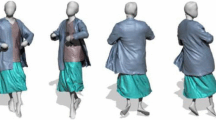Abstract
In this paper we propose a novel method for building animation model of real human body from surface scanned data. The human model is represented by a triangular mesh and described as a layered geometric model. The model consists of two layers: the control skeleton generating body animation from motion capture data, and the simplified surface model providing an efficient representation of the skin surface shape. The skeleton is generated automatically from surface scanned data using the feature extraction, and then a point-to-line mapping is used to map the surface model onto the underlying skeleton. The resulting model enables real-time and smooth animation by manipulation of the skeleton while maintaining the surface detail. Compared with earlier approach, the principal advantages of our approach are the automated generation of body control skeletons from the scanned data for real-time animation, and the automatic mapping and animation of the captured human surface shape. The human model constructed in this work can be used for applications of ergonomic design, garment CAD, real-time simulating humans in virtual reality environment and so on.
Similar content being viewed by others
References
Jones P R M, Rioux M. Three-dimensional surface anthropometry: Applications to the human body.Optics and Lasers in Engineering, 1997, 28(2): 89–117.
Hoppe H. Progressive meshes. InProc. the ACM SIGGRAPH Conference on Computer Graphics, ACM Press, 1996, pp.99–108.
Soucy M, Laurendeau D. Multiresolution surface modeling based on hierarchical triangulation.Computer Vision and Image Understanding, 1996, 63(1): 1–14.
Liu Y J, Yuen Matthew M F. Optimized triangle mesh reconstruction from unstructured points.The Visual Computer, 2003, 19(1): 23–37.
Wang Charlie C L, Chang Terry K K, Yuen Matthew M F. From laser-scanned data to feature human model: A system based on fuzzy logical concept.Computer-Aided Design, 2003, 35(3): 241–253.
Lewis J P, Cordner M, Fong N. Pose space deformation: A unified approach to shape interpolation and skeleton-driven deformation. InProc. the ACM SIGGRAPH Conference on Computer Graphics, ACM Press, 2000, pp.165–172.
Shen J, Thalmann D. Interactive shape design using metaballs and splines. InProceedings of Eurographics Workshop on Implicit Surfaces'95, Grenoble, France, 1995, pp.187–196.
Chadwick J E, Haumann D R, Parent R E. Layered construction for deformable animated characters.ACM SIGGRAPH Computer Graphics, 1989, 23(3): 243–252.
Forsey D R. A surface model for skeleton-based character animation. InProc. the Second Eurographics Workshop on Animation and Simulation, Vienna, Austria, 1991, pp.55–73.
Turner R, Gobbetti E. Interactive construction and animation of layered elastically deformable characters.Computer Graphics Forum, 1998, 17(2): 135–152.
Lander J, Skin them bones: Game programming for the web generation.Game Developer Magazine, 1998, 5: 11–16.
Sun W, Hilton A, Smith R, Illingworth J. Layered animation of captured data.The Visual Computer, 2001, 17(8): 457–474.
Brett A, Brian C, Zoran P. Articulated body deformation from range scan data.ACM Trans. Graphics, 2002, 21(3): 612–619.
Cyberware Inc. http://www.cyberware.com/.
Dekker L, Khan S, West E, Buxton B, Treleaven P. Models for understanding the 3D human body form. InProc. IEEE International Workshop on Model-Based 3D Image Analysis, Bombay, India, 1998, pp.65–74.
Oliveira J, Buxton B. Light weight virtual humans. InProc. Eurographics-UK 2001, London-UK, 2001, pp.45–52.
Dekker L, Douros I, Buxton B, Treleaven P. Building symbolic information for 3D human body modeling from range data. InProc. the Second International Conference on 3D Digital Imaging and Modeling, IEEE Computer Society, 1999, pp.388–397.
Koivo A J. Fundamentals for Control of Robotics Manipulators, New York, John Wiley & Sons Inc. 1989.
Thomopoulos S C A, Tam R Y J. Interactive solution to the inverse kinematics of robotics manipulators.Mechanism and Machine Theory, 1991, 26: 359–373.
Hilton A, Beresford D, Gentils T, Smith R, Wei Sun. Virtual people: Capturing human models to populate virtual worlds. InIEEE International Conference on Computer Animation Proceedings, 1999, pp.174–185.
Alvin R T, Henry D A. The Measure of Man and Woman: Human Factors in Design. Revised Edition, New York, John Wiley & Sons Inc. 2001, pp.10–46.
Teichmann M, Teller S. Assisted articulation of closed polygonal models. InThe 9th Eurographics Workshop on Animation and Simulation Proceedings, 1998, pp.87–101.
Babski C, Thalmann D. A seamless shape for HANIM compliant bodies. InProc. VRML 99, ACM Press, 1999, pp.21–28.
Author information
Authors and Affiliations
Corresponding author
Additional information
This work is supported by the National Natural Science Foundation of China (Grant No.60174023) and the National Research Foundation for the Doctoral Program of Higher Education of China (Grant No.20010248008).
Yong-You Ma received his M.S. degree in mechanical engineering from Kunming University of Science and Technology in 2000. He is currently a Ph.D. candidate in the Institute of Graphical Techniques & CAD, Shanghai Jiaotong University. His research interests include geometric modeling, reverse engineering computer graphics and animation.
Hui Zhang received his M.S. degree from Gansu University of Technology in 2000. Now he is a Ph.D. candidate in the Institute of Graphical Techniques & CAD, Shanghai Jiaotong University. His main research interests include modern design methodology, visual design, CAD and graphics technology.
Shou-Wei Jiang graduated from Shanghai Jiaotong University in 1960. He is now a professor and Ph.D. supervisor in the School of Mechanical Engineering in Shanghai Jiaotong University. His main research interests include modern design methodology, engineering graphics, CAD and visual design. He has published over 40 papers and 10 books in these fields.
Rights and permissions
About this article
Cite this article
Ma, YY., Zhang, H. & Jiang, SW. Realistic modeling and animation of human body based on scanned data. J. Compt. Sci. & Technol. 19, 529–537 (2004). https://doi.org/10.1007/BF02944754
Received:
Revised:
Issue Date:
DOI: https://doi.org/10.1007/BF02944754




